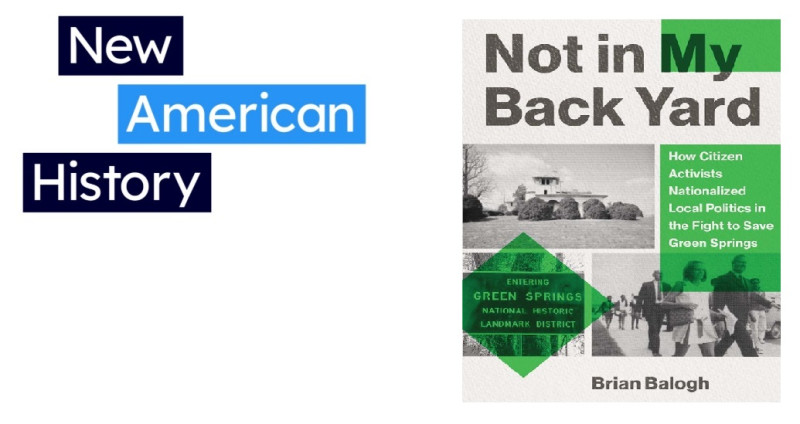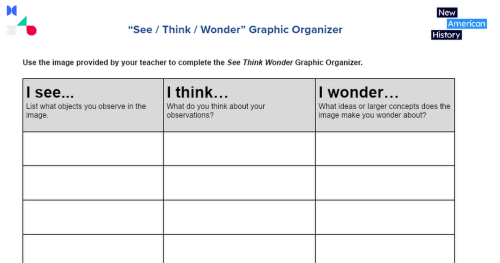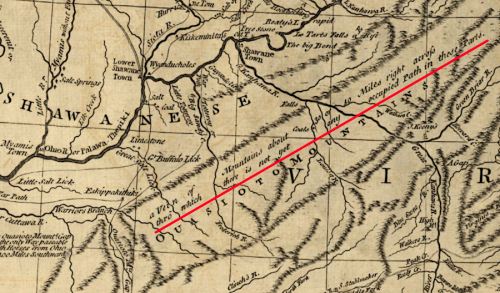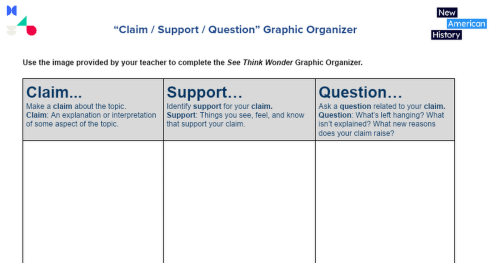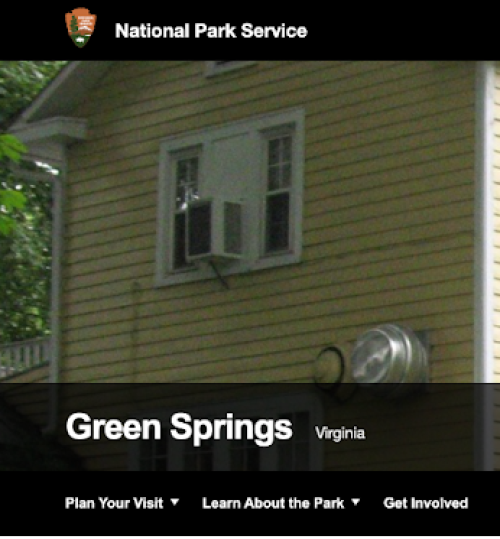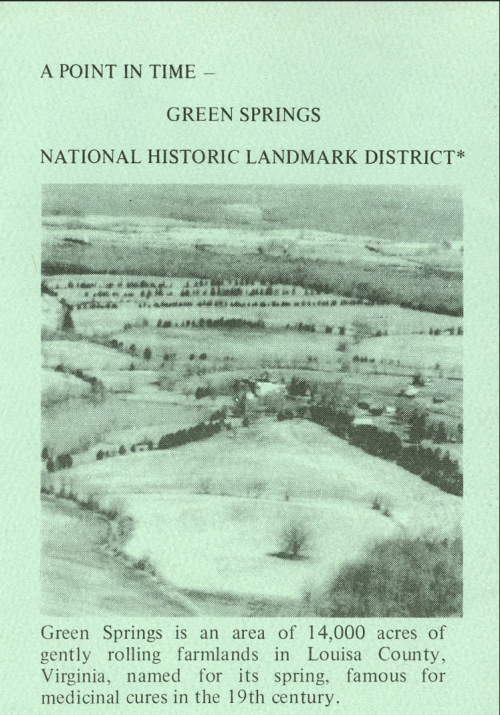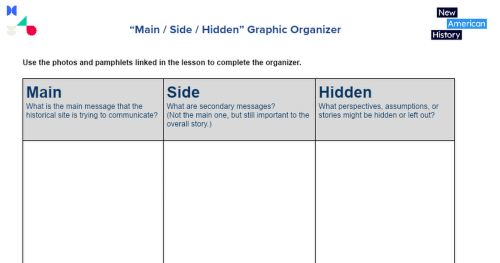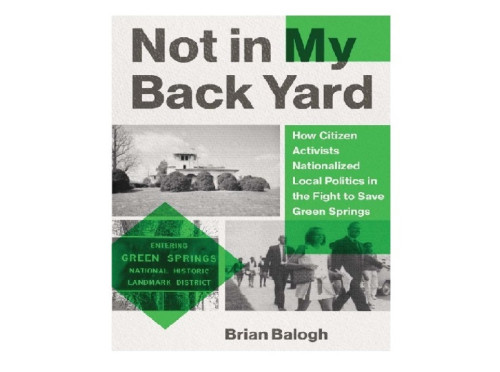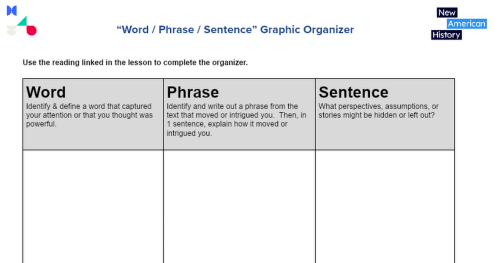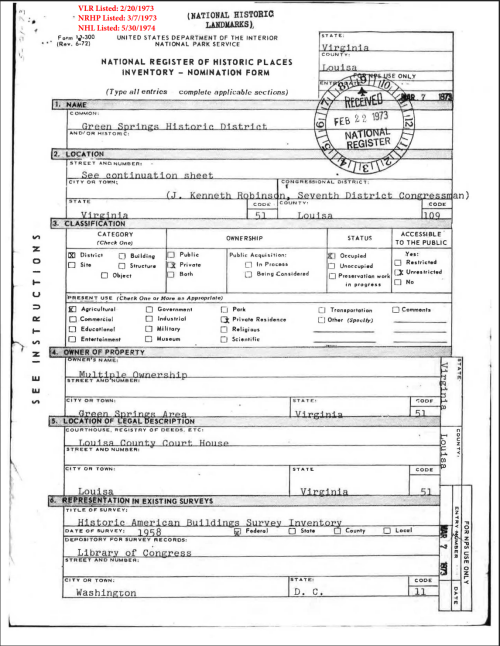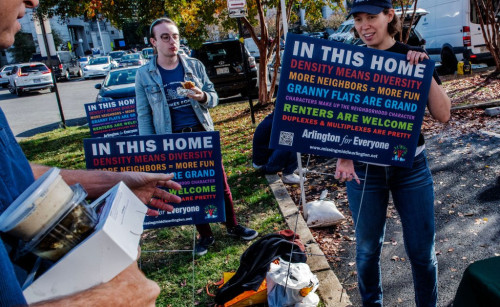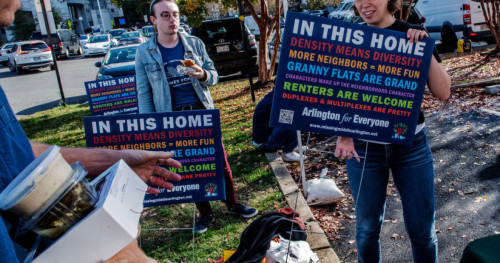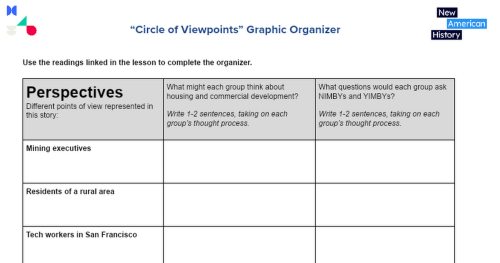This work by New American History is licensed under a Attribution-NonCommercial-ShareAlike 4.0 (CC BY-NC-SA 4.0) International License. Permissions beyond the scope of this license may be available at newamericanhistory.org.
Not In My Backyard: Green Springs Historic District
View Student Version
Standards
C3 Framework:D2.His.3.6-8.D2.His.3.9-12.
National Council for Social Studies:Theme 2 - TIME, CONTINUITY, AND CHANGETheme 5 - INDIVIDUALS, GROUPS, AND INSTITUTIONS
National Geography Standards: Standard 17: How to apply geography to interpret the past
College Board AP U.S. History (Fall 2020)HISTORICAL THINKING SKILLS COVERED: SKILL 4.A – Identify and describe a historical context for a specific historical process or development.SKILL 5.A: Identify patterns or connections between historical developments.TOPIC 8.13: The Environment and Natural Resources from 1968 to 1980 – Environmental problems and accidents led to a growing environmental movement that aimed to use legislative and public efforts to combat pollution and protect natural resources. The federal government established new environmental programs and regulations.TOPIC 8.14: Society in Transition – The 1970s saw growing clashes between conservatives and liberals over social and cultural issues, the power of the federal government, race, and movements for greater individual rights.
EAD FrameworkTHEME 1: Civic ParticipationTHEME 7: A People with Contemporary Debates and Possibilities
Teacher Tip: Think about what students should be able to KNOW, UNDERSTAND and DO at the conclusion of this learning experience. A brief exit pass or other formative assessment may be used to assess student understandings. Setting specific learning targets for the appropriate grade level and content area will increase student success.
Suggested Grade Levels: High School (9-12), U.S. History, Advanced Placement U.S. History, U.S. Government, Advanced Placement U.S. Government courses
Suggested Timeframe: 2 or 3 90-minute class periods
Suggested Materials: Internet access via laptop, tablet or mobile device
Key Vocabulary
Activist - An activist is an ordinary person who participates in collective action to influence political and social outcomes for the common good, aiming to drive policy changes, hold institutions accountable, and increase democratic participation. Often called “citizen activism,” their actions encompass a wide range of efforts, from fighting for local issues like better schools to supporting broader movements for social justice, civil rights, and environmental protection. Rural activism is also used in this lesson and refers to those active in rural communities (see “rural” below).
Anti-Vietnam War Movement - a mass, grassroots effort to end U.S. involvement in the Vietnam War, peaking in the late 1960s and early 1970s through protests, draft resistance, and civil disobedience. Fueled by widespread opposition and led by student organizations such as the Students for a Democratic Society (SDS), the movement employed tactics ranging from peaceful marches to draft card burnings and even property damage.
Civil Rights Movement - a social movement, primarily from 1954 to 1968, aiming to end legalized racial segregation, discrimination, and disenfranchisement in the United States, which disproportionately affected African Americans. Through strategies like nonviolent direct action (boycotts, sit-ins), litigation, and lobbying, activists secured landmark legislation such as the Civil Rights Act of 1964 and the Voting Rights Act, dramatically transforming American law and public practice to uphold constitutional rights for all citizens regardless of race, sex, or origin.
Dogged persistence - a stubborn and/or unwavering determination to continue with a goal or task despite difficulties, danger, or setbacks
Ely, Rae - born in 1941, moved to Green Springs, Virginia with second husband Hiram Ely, became a neighborhood activist to block the building of a prison and mining site, graduated from the University of Virginia Law School without ever receiving an undergraduate degree
Green Springs, Virginia - a rural region within Louisa County in Central Virginia
Holton, Linwood - the first elected Republican governor of Virginia of the 20th century, led from 1970 to 1974
Louisa County, Virginia - rural county in Central Virginia, population 37,596 (2020)
National Historic Landmark District - a geographic area formally recognized by the U.S. government for its historic and cultural importance
NIMBY - (acronym for Not in My Backyard), a person or group that opposes real estate development or infrastructure projects
Rehabilitation center - a facility that helps people restore mental or physical abilities lost due to illness, injury, or addiction, enabling them to function at their highest possible level. Centers cater to a range of needs, from recovering from stroke or surgery to treating substance abuse or mental health disorders, and can be private or public entities
Vermiculite - a mineral used in gardening for aeration and in construction as loose-fill insulation
YIMBY - (acronym for Yes in My Backyard), a person or group in favor of real estate development or infrastructure projects
Read for Understanding
Teacher Tips
New American History Learning Resources may be adapted to a variety of educational settings, including remote learning environments, face-to-face instruction, and blended learning.
If you are teaching remotely, consider using videoconferencing to provide opportunities for students to work in pairs or small groups. Digital tools such as Google Docs or Google Slides may also be used for collaboration. Rewordify helps make a complex text more accessible for those reading at a lower Lexile level while still providing a greater depth of knowledge.
These Learning Resources use Harvard University’s Project Zero thinking routines. The specific routines used are: the See-Think-Wonder thinking routine, the Claim-Support-Question thinking routine, the Main-Side-Hidden thinking routine, the Word-Phrase-Sentence thinking routine, and the Circle of Viewpoints thinking routine.
These Learning Resources follow a variation of the 5Es instructional model, and each section may be taught as a separate learning experience or as part of a sequence of learning experiences. We provide each of our Learning Resources in multiple formats, including web-based and as an editable Google Doc for educators to teach and adapt selected learning experiences as they best suit the needs of your students and local curriculum. You may also wish to embed or remix them into a playlist for students working remotely or independently.
For Students:
How should a locality change, and who gets to decide? Green Springs, a rural neighborhood in Central Virginia, faced these questions in the early 1970s. The governor sought the site to improve conditions for his state’s prison system, and, when that effort was blocked, a mining company wanted to stake its claim for the land. This learning resource explores the story of an unlikely female activist named Rae Ely and how the dogged persistence of citizen activism can impact the fate of a neighborhood.
Engage:
How does local history improve our understanding of America’s national story?
The study of local history grounds us in specific lives and localities. It offers the chance to zoom in and understand one situation intimately, but then to zoom out and connect the situation to larger political, economic, and cultural patterns. Historian Ed Ayers explains the value in studying local histories in his article entitled “All History is Local.”
We need to see history with bifocals - up close and as part of a pattern.
QUOTE ANALYSIS – Analyze this quote independently using the See-Think-Wonder thinking routine:
- What do you notice in the quote (key words, tone)?
- What do you think the quote means?
- What follow-up questions do you have to better understand the quote?
Share your responses as a group of three or four. Nominate a record keeper, and record your answers in this graphic organizer.
Then, nominate a group reporter and discuss as a class.
After the quote discussion, read the full article independently.
After you read, use the Claim-Support-Question thinking routine. Your teacher may provide a paper copy or allow you to make a digital copy of this graphic organizer to help you capture your thoughts.
Respond to these questions after completing your graphic organizer:
- What is Ayers’ main claim?
- What evidence does Ayers use to support this claim?
- What questions do you still have about the claim or the evidence?
Share your responses in the same group of three or four. Nominate a different group reporter and discuss as a class.
Your teacher may ask you to record your answers on an exit ticket.
Explore:
What is the Green Springs National Historic Landmark District?
After years of fighting by resident Rae Ely, a tract of land in Green Springs, Virginia, became America’s first rural National Historic Landmark District in 1974. The parcel was eyed as a spot for a prison and a strip-mining company, but Ely’s grassroots campaign thwarted the efforts of the local political machine.
Learn more about the Green Springs National Historic Landmark District by exploring this National Park Service website and this brochure from the National Park Service Library and Archives for additional images and stories.
Organize your observations in pairs by using the Main-Side-Hidden thinking routine. Answer these questions, using this graphic organizer.
- What is the main message that the historical site is trying to communicate?
- "What are the possible secondary messages in the site's content?"
- What perspectives, assumptions, or stories might be hidden or left out?
Nominate a group reporter and discuss the observations as a class.
Your teacher may ask you to record your answers on an exit ticket.
Explain:
How did Rae Ely and fellow activists save their neighborhood from unchecked economic development?
Rae Ely and her husband moved to Louisa County, Va., in 1967. Ely knew little about politics or property law, but that didn’t deter her from becoming a local activist leader and creating the non-profit Historic Green Springs, Inc. Ely first challenged Virginia Governor Linwood Holton over the possible construction of a state prison across from Ely’s home in the early 1970s and later took on a multinational mining company that wanted to mine the neighborhood for vermiculite.
On your own, read the introduction to historian Brian Balogh’s book “Not in My Backyard” (pages 1 to 10). Stop after each page and use the Word-Phrase-Sentence thinking routine. Complete this graphic organizer.
- Choose a word that captured your attention or that you thought was powerful.
- Choose a phrase that moved or intrigued you.
- Choose a sentence that you felt captured the core idea of the text.
After you read the 10 page excerpt, work in small groups as directed by your teacher to answer these questions.
- Who is Rae Ely, and how did she become a citizen activist?
- According to Balogh, what does the term “Not in My Backyard” (NIMBY) mean, and how does it relate to Ely?
- What tactics did Ely use to challenge the prison and mining projects?
- How is this story an example of the tension between local control and federal power in the American political system?
Nominate a group member to report out. Discuss the questions as a class.
Your teacher may ask you to record your answers on an exit ticket.
Elaborate:
How did Ely and other activists convince the federal government to preserve Green Springs?
One evening in the Spring of 1970, Rae Ely and her husband, Hiram, watched the TV news in their home in Green Springs, Virginia. They had moved there three years before to enjoy a more rural setting than suburban New Jersey and to distance themselves from tensions in their family. On the news was a story that shocked: Governor Linwood Holton planned to build a rehabilitation center for convicted felons across the street from their house. The center was part of Governor Holton’s plan to reform Virginia’s criminal justice system. After hearing the report, Rae turned to her husband, Hiram, and asked: “What are you going to do about this?” And so started the Ely family’s fight to block the prison project.
Linked below is a PDF document copy of the nomination form that was sent to the U.S. Department of the Interior in 1973. It represents the argument made by the Elys and their neighbors for the federal government to recognize their Green Springs neighborhood as a National Historic Landmark District.
With a partner, read through the document and answer these questions:
- Who created this document?
- What kind of document is it? Who is its intended audience?
- What do you think was the author’s purpose in creating this document?
- According to the document, how is Green Springs historically unique?
- What are two supporting details that support the claim that Green Springs should be recognized as a National Historic Landmark District?
- If you were the federal official who had to decide if Green Springs were to be a National Historic Landmark District, would this convince you to do so? Explain your reasoning.
Share your responses with another partner group. Compare your findings.
Your teacher may ask you to record your answers on an exit ticket.
Extend:
How much should a neighborhood change, and who should decide?
Rae Ely and other neighborhood activists in the early 1970s used strategies from the civil rights, women’s, and anti-Vietnam War movements to protest their neighborhood’s quality of life. Today, these activists are labelled NIMBYs (Not in My Backyard), and the term refers to those who oppose real estate developments or infrastructure projects. NIMBY has taken on a negative connotation, as someone who holds back growth and fears change in a neighborhood.
But historian Brian Balogh writes in Time magazine that the issue is more complicated than NIMBY vs. YIMBY (Yes in My Backyard).
Read Balogh’s article independently and answer the questions below:
- What is Balogh’s main claim?
- Cite two examples that support the claim.
- According to Balogh, how has the view of NIMBYs changed over time?
- According to Balogh, what do today’s YIMBYs have in common with NIMBYs?
Explore this Bunk connection:
After you explore, use the Circle of Viewpoints thinking routine to examine the different perspectives mentioned in the two articles:
- mining executives
- residents of a rural area
- tech workers in San Francisco
- a local political leader in a rural area
Turn and talk to a partner.
Complete this graphic organizer. For each perspective, answer these questions with your partner, then share your ideas with another set of partners in your class, as directed by your teacher.
- What might each group think about housing and commercial development?
- What questions would each group ask NIMBYs and YIMBYs?
Nominate a member from the group to report out your ideas and discuss as a whole class.
Your teacher may ask you to record your answers on an exit ticket.
Citations:
Ayers, Ed. 2021. “All History Is Local.” Medium. A Medium Corporation. February 26, 2021. https://medium.com/new-american-history/all-history-is-local-be096696291b
Balogh, Brian. Not in My Backyard: How Citizen Activists Nationalized Local Politics in the Fight to Save Green Springs. United States: Yale University Press, 2024
Balogh, Brian. “NIMBYs and YIMBYs Have More in Common than It Might Seem.” Time. February 6, 2024. https://time.com/6565036/nimbys-vs-yimbys/
Harvard Graduate School of Education. 2022. “PZ’s Thinking Routines Toolbox | Project Zero.” Pz.harvard.edu. Harvard Graduate School of Education. 2022. https://pz.harvard.edu/thinking-routines
National Park Service, U.S. Department of the Interior. 2022. “Green Springs (U.S. National Park Service).” Nps.gov. 2022. https://www.nps.gov/grsp/index.htm
National Park Service, U.S. Department of the Interior. nd. “A Point in Time - Green Springs”. https://npshistory.com/brochures/nhl/green-springs-hd.pdf
“NATIONAL REGISTER of HISTORIC PLACES INVEMTORY - NOMINATION FORM.” 2AD. Https://Www.dhr.virginia.gov/Wp-Content/Uploads/2018/04/054-0111_GreenSpringsRuralHD_1973_Nomination_NHL-NRHP.pdf
“Nimbys and YIMBYS Have More in Common than It Might Seem.” Bunk History. Accessed July 2, 2025. https://www.bunkhistory.org/resources/nimbys-and-yimbys-have-more-in-common-than-it-might-seem/connections?type=place&res=13528
NPS History Electronic Library & Archive. n.d. “A POINT in TIME - GREEN SPRINGS NATIONAL HISTORIC LANDMARK DISTRICT.” National Park Service History. Accessed July 2, 2025. https://npshistory.com/brochures/nhl/green-springs-hd.pdf
Vigots, Alice. ‘Thinking Pathways’ website. “Main-Sided-Missed” from https://thinkingpathwayz.weebly.com/routinesdiggingdeeper.html Shared with Creative Commons Attribution-NonCommercial-ShareAlike 4.0 International License. Accessed September 17, 2025
View this Learning Resource as a Google Doc


